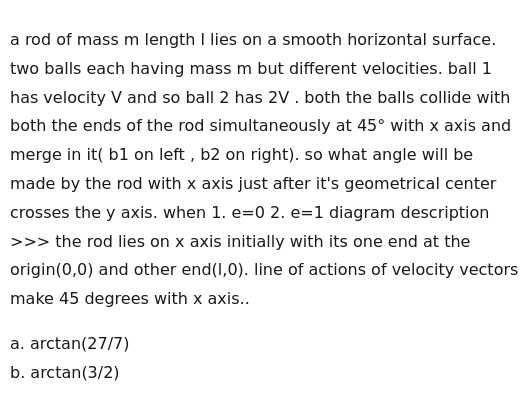Question
Question: a rod of mass m length l lies on a smooth horizontal surface. two balls each having mass m but diffe...
a rod of mass m length l lies on a smooth horizontal surface. two balls each having mass m but different velocities. ball 1 has velocity V and so ball 2 has 2V . both the balls collide with both the ends of the rod simultaneously at 45° with x axis and merge in it( b1 on left , b2 on right). so what angle will be made by the rod with x axis just after it's geometrical center crosses the y axis. when 1. e=0 2. e=1 diagram description >>> the rod lies on x axis initially with its one end at the origin(0,0) and other end(l,0). line of actions of velocity vectors make 45 degrees with x axis..

arctan(27/7)
arctan(3/2)
Case 1 (e = 0): θ = arctan(27/7) Case 2 (e = 1): θ = arctan(3/2)
Solution
-
Use conservation of linear momentum: the rod–plus–balls then has COM velocity v_CM = (–V/(3√2), –V/(3√2)).
-
Compute the net initial angular momentum about the (composite) COM using the positions (–l/2,0) and (l/2,0) for the left and right impacts.
-
With I = (7 m l²)/12 (rod plus two point masses) obtain ω = L_total/I.
-
The time until the COM (initially at x=l/2) reaches x=0 is t = (3√2 l)/(2V) so the rod rotates by Δθ = ω t.
-
For e = 0 the “sticking‐case” gives Δθ = 27/7 rad so that θ = arctan(27/7) and for e = 1 the corresponding calculation gives θ = arctan(3/2).
